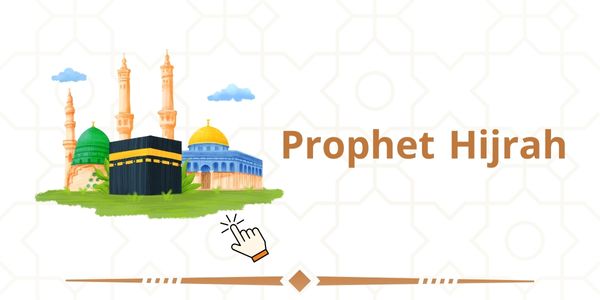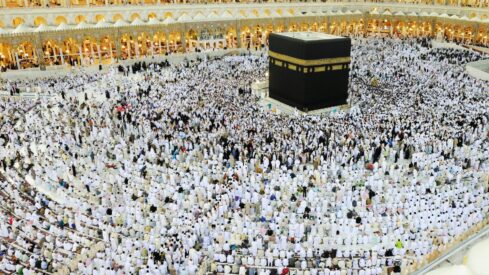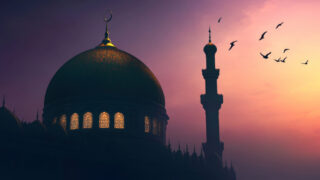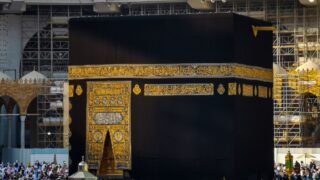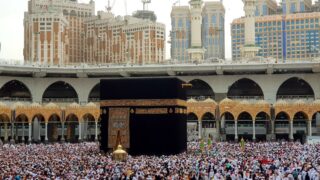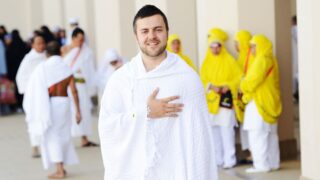Islam is a religion of relatively few symbols because it is an open, rational and practical faith. Where symbols do occur, their nature conforms with and confirms the nature of the faith.
The central and foremost symbol of Islam is the Kabah and the rituals associated with it. In the Qur’an, God calls the Kabah Al-Bayt al-Haram (the Sacred House) and Bayt Allah (House of God). This Sanctuary of God is a tangible point in space and time to assemble and “visit”. It represents how the Muslim’s world and life revolve around an exclusive and pure devotion to the One True God.
The pilgrim who visits the Kabah must be motivated by a consuming faith and pure devotion, for there is little worldly enjoyment there in the midst of the burning desert. The Kabah is the simple cube stone building in Makkah. Within a few hundred meters of it are other sites associated with the sanctification of Umm Al-Quraa (the Mother of Cities, i.e., Makkah). These sites are two little hills named Marwa and Safa and the Well of Zamzam. The water of this well originally sprang from under the feet of the infant Ishmael (Ismail) and has flowed ever since then for the pilgrims. Indeed, this water made settlement in Makkah possible. These sites are integral to the rites of Hajj and are enclosed in the Noble Sanctuary.
The foundations of the Kabah were laid by Abraham (Ibrahim) and his son Ishmael (Ismail — peace be upon them), and it was consecrated to the worship of the One True God. However, over the millennia, human folly added to the Kabah so that by the half millennium preceding Prophet Muhammad (peace and blessings be upon him), the worship conducted there had degenerated into paganism and idolatry. The Kabah was surrounded by more than three hundred idols. The Abrahamic origins of the faith and its heritage of pure monotheism were all but buried. Yet it retained its aura of sacredness, and one “heretic” sect refused the customs of the people to nurture a memory and conviction of the One True God. Another residue of the Abrahamic tradition was a cult of peace and asylum related to the Sanctuary.
The message of Islam was not new – what was new was the form of this message, its dimensions and scale by the time Prophet Muhammad (peace and blessings be upon him) was born, Makkah was submerged in polytheism and idolatry. Only vestiges of the pure faith remained in a symbol and a tradition. Thus, the mission of the Prophet Muhammad (peace and blessings be upon him) was the fulfillment of Revelation, of the Message of Guidance, not its beginning. It came to restore the faith to its original purity. Hence the message of Islam was not new. What was new was the form of this message, its dimensions and scale. The message would henceforth be preserved in a Book (the Qur’an) that would be immune to the ravages of time and the folly of man but that would be accessible to all who sought the Guidance. The repository of the faith was in the Community at large. No group could claim the privilege of special knowledge or a mission not open to others. No group or individual could come between the human being and Creator. Clergies and theocracies would be obsolete. These are the chief implications of the new form of this Last Guidance. They underline the liberating essence of its core concept and foundation: tawheed.
This liberating essence constitutes the revolutionary component and the regenerative momentum of the faith. These elements continue to retain their force and relevance because of the uncontaminated purity of its sources and its core tenets. Here are some aspects of the enduring symbolism of the Kabah:
The Kabah is symbolic of an essence: the idea of the prime and the core. It has remained at the center of a continuous tradition of human worship and devotion. It symbolizes the integrating and unifying power of monotheism in human life. The idea of the prime and the core reinforces and confirms the basic concepts of Islam as the religion of pure monotheism, and hence as the one true religion for all men and for all time. Abraham is upheld in the Qur’an not for his ancestry of the Arabs, but for being the model and the archetype of the Muslim. In its association with the Abrahamic tradition and its commemoration of it, the Kabah symbolizes the unity of all true religion, celebrates the brotherhood of all prophets, and the essential unity of their message.
The Kabah is not just associated with the beginnings of the pure faith and of religion. It symbolizes the message that was addressed to the People of the Book — the Jews and Christians — in order to resolve the points of dispute among them. The mission of the last messenger, Muhammad (peace and blessings be upon him), was to inaugurate an era in which Divine Guidance was openly universal, wider and more comprehensive in scope, with its injunctions spelled out in detail. The responsibility for man’s fate and moral well-being would come to rest squarely on his own free choice and on a willing initiative to respond to his Creator. The Kabah also symbolizes the common orientation and common goal of mankind: its response to the One True God. Every mosque has a mihrab (niche) that points in the direction of the Kabah. Wherever a Muslim stands to pray, bow and prostrate, he faces in the direction of the Kabah, thus reminding him of the source of identity and common purpose and goal that binds him to his community in faith.
The Kabah is symbolic both of permanence and constancy and of renewal and renewability. Upon entering the precincts of the Holy Sanctuary, every Muslim makes a pledge as he approaches the Kabah. He faces its door and, before beginning tawaf (circumambulation), he renews his commitment by professing the Shahadah, the Testimony of Faith (“I bear witness that there is no god but Allah; I bear witness that Muhammad is the Messenger of Allah”). Standing in solemn humility at this station, the Muslim identifies with a whole series of similar stations and situations in which the oath of allegiance was taken, whether during the lifetime of the Prophet Muhammad (peace and blessings be upon him) or at any time since Abraham and Ishmael (peace be upon them) pledged to God and laid the foundations of the Kabah. For this reason, the door of the Kabah is known as Bab Al-Multazim, the door of the one who takes the oath or makes the pledge.
Bab Al-Multazim is just one detail of the entire state of ihram, the state of sanctification and abstinence of the pilgrim. The pilgrim settles all his worldly debts, and then removes his worldly attire. He bathes and dresses in the fresh attire of the pilgrim and rededicates himself to the Way of his Creator.
The preservation of the Ka`bah as a living symbol down the generations to this day and age and its continuity as a haven of devotion, a shelter of refuge, and a site of grace is, in itself, a sign that invites serious reflection by all those who truly care to think.
Summarized from Introducing Islam from Within by Mona Abul-Fadl (Leicester, UK: The Islamic Foundation, 1991). Used with permission.

